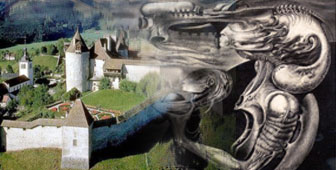Walking on the wild side in Gruyères

The medieval hilltop town of Gruyères has more to offer than just meringues, double cream and cheese to visitors. Behind its fortified walls, Scott Capper discovered a trove of surrealistic fantastic art.
Climb the hill past the first fortified wall. Walk past the shops and restaurants serving up cream, meringues and fondue. At the chapel in the middle of town, turn left and keep on climbing.
Bypass the home of Chalamala, the court jester, with its tiny door and dragon’s head drainpipe. And when you reach the second gateway to the castle, turn around and say goodbye to most of the town’s visitors.
Beyond this point, you may just start to feel a little lonely, or definitely in a different place. Just to your left you’ll see the residents of an old age home, to your right, something somewhat creepier.
Statues of humanoid variety
The Château Saint-Germain is an old manor house sitting right behind the old walls. And so far, nothing special about it, although a local journalist recently wrote ironically that its international reputation “was bigger than that of Emmental cheese and some well-known Swiss politicians put together”.
The handrail leading into the building looks a little odd, and upon closer inspection turns out to be some kind of giant backbone. On both sides of the door, strange statues of the humanoid variety guard the entrance.
No mistake here, the building houses the personal art collection of Swiss artist H.R. Giger, made up mostly of his own work. Giger is the man behind the monster (and the sets) in the famous Alien series, starring Sigourney Weaver.
The museum isn’t just about an alien though. In fact, the interior of the building is slowly becoming an integrated work of art.
Special cement and rubber tiles cover the floors, as they do the walls. The cashier’s desk in the lobby is supported by alien backbones.
To see the art, head upstairs. Giger has not just created new works of art to fill the museum; he has gone as far as buying back pieces from private collectors around the world.
The first paintings on view set the tone of what is to follow. His work is not easy on the eye, centred on what he calls biomechanical creatures with a strong emphasis on detail.
Depictions of sexuality and violence
The artist often uses monochromatic paint schemes to portray his fantasy world. His pictures also seem to stem from the darker recesses of the brain, with frequent depictions of sexuality and violence.
Yet Giger is neither a troubled person, nor the Devil according to Barbara Gawrysiak, the director of the museum. “His work is entirely different from his personality”, she says.
The star of the museum is of course the Alien, with its model lurking in a darkened glass case, surrounded by sketches and other depictions of the creature.
And just in case you didn’t know, he is in fact a she, although nobody fleeing its clutches would care to check.
Giger isn’t just about paintings and drawings, he is also a designer although his furniture could not be described as comfy. His idea of elegant dining, as shown in the museum, is reflected in his use of chairs with a skeleton structure.
The third floor of the building houses works of other artists Giger has been collecting since the early 1970s. He has however avoided buying art which resembles his own.
Museum in castle
For a further fill of surrealism, I headed up the hill to the belly of the medieval castle. The former seat of the county of Gruyère has long housed a museum of its own, with a disparate collection of items from its history.
Two giant shields, the work of Patrick Woodroffe, guard the entrance to the old fortress. One represents Mars, the god of war, the other Venus, the goddess of love.
Beyond that point, one has to search for the fantastic art collection, hidden between medieval objects and furniture and decorations left by the castle’s 19th century owner.
It is only recently that the old building became the residence of a small collection of fantastic art set up by the former director. Woodroffe, the set designer for the movie Neverending Story, is perhaps the best-known artist represented there.
The Englishman’s work is also to be found in the prisoner’s tower, where photographic reproductions can be viewed up and down a spiral staircase. The other artists displayed in the castle are lesser-known lights of the fantastic art movement such as Salerni, Goldschmiedt or Roosevelt.
This lack of recognition is not only due to a lack of recognisable style, but the director of the castle museum, Raoul Blanchard, says the public also has trouble identifying itself with this type of surrealism.
Fantastic art is a feast for the eyes (if not an orgy at times) and it can leave you feeling bloated. Or like good wine, a little light-headed.
To get your breath back, just head to the back of the castle and look at the view of the mountains, certainly a good reason to make a trek up the hill.
by Scott Capper

In compliance with the JTI standards
More: SWI swissinfo.ch certified by the Journalism Trust Initiative








You can find an overview of ongoing debates with our journalists here . Please join us!
If you want to start a conversation about a topic raised in this article or want to report factual errors, email us at english@swissinfo.ch.